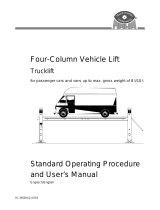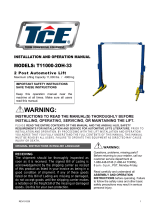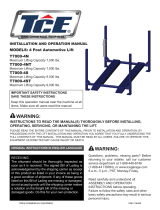Page is loading ...

MPJ 16.5/1200 2S | 3S
Pit Jack
Original Operating Instructions
BA551501-en
MPJ 16.5/1200 2S A
MPJ 16.5/1200 2S A
MPJ 16.5/1200 2S A
MPJ 16.5/1200 3S A
MPJ 16.5/1200 3S A

2 BA551501-en
BA551501-en
2021-03-15
© MAHA Maschinenbau Haldenwang GmbH & Co. KG
The reproduction, distribution and utilization of this document as well as the communication of its contents
to others without explicit authorization is prohibited. Offenders will be held liable for the payment of
damages. All rights reserved in the event of the grant of a patent, utility model or design.
The contents of this edition have been checked with great care. However, errors cannot be fully excluded.
Subject to technical change without notice.
Manufacturer
MAHA Maschinenbau Haldenwang GmbH & Co. KG
Hoyen 20
87490 Haldenwang
Germany
Phone: +49 8374 585-0
Fax: +49 8374 585-590
Mail: [email protected]
Web: www.maha.de
Service
MAHA SERVICE CENTER
Maybachstraße 8
87437 Kempten
Germany
Phone: +49 8374 585-100
Fax: +49 8374 585-491
Mail: service@maha.de
Web: www.mahaservicecenter.de

BA551501-en 3
Contents
1 Safety ................................................................................................................................................................ 5
1.1 Symbols and Signal Words ......................................................................................................................... 5
1.1.1 Personal Injury ....................................................................................................................................... 5
1.1.2 Property Damage .................................................................................................................................. 5
1.1.3 Information ............................................................................................................................................ 5
1.2 Intended Use ................................................................................................................................................ 6
1.3 Inappropriate Use ........................................................................................................................................ 6
1.4 Requirements on Operating and Service Personnel .................................................................................. 6
1.5 Safety Instructions for Operation ............................................................................................................... 7
1.6 Safety Instructions for Handling Hydraulic Fluid ....................................................................................... 9
1.7 What to Do in the Event of Defects or Malfunctions ................................................................................. 9
1.8 What to Do in the Event of an Accident ...................................................................................................... 9
2 Description ....................................................................................................................................................... 9
2.1 Design and Operating Principle .................................................................................................................. 9
2.2 Compressed Air Supply ............................................................................................................................. 10
2.3 Sample Nameplate .................................................................................................................................... 11
2.4 Technical Data ........................................................................................................................................... 11
3 Transport and Storage ................................................................................................................................... 13
4 Installation and Initial Operation ................................................................................................................... 13
5 Operation ........................................................................................................................................................ 20
5.1 Controls and Indicators ............................................................................................................................. 20
5.1.1 Double Telescopic Jack ...................................................................................................................... 20
5.1.2 Triple Telescopic Jack ........................................................................................................................ 22
5.2 Checking the Safety Device ....................................................................................................................... 24
5.3 General Operating Instructions for Lifting Accessories .......................................................................... 24
6 Maintenance ................................................................................................................................................... 26
6.1 Annual Inspection ...................................................................................................................................... 26
6.2 Care Instructions ....................................................................................................................................... 26
6.3 Refilling with Hydraulic Fluid ..................................................................................................................... 27
6.4 Maintenance by the Operator.................................................................................................................... 28
6.5 Troubleshooting ......................................................................................................................................... 30
6.6 Spare Parts ................................................................................................................................................. 32
7 Service Lifetime ............................................................................................................................................. 32
8 Dismantling .................................................................................................................................................... 32
9 Disposal .......................................................................................................................................................... 32
10 Contents of the Declaration of Conformity .................................................................................................. 33

4 BA551501-en

BA551501-en 5
1 Safety
Thoroughly read this manual before operating the equipment and comply with
the instructions. Always display the manual in a conspicuous location.
Personal injury and property damage incurred due to non-compliance with these
safety instructions are not covered by the product liability regulations.
1.1 Symbols and Signal Words
1.1.1 Personal Injury
DANGER
indicates an immediate hazard which, if not avoided, will result in death or
severe personal injury.
WARNING
indicates a potential hazard which, if not avoided, could result in death or severe
personal injury.
CAUTION
indicates a potential hazard which, if not avoided, could result in moderate or
minor personal injury.
1.1.2 Property Damage
NOTICE
indicates a potentially harmful situation which, if not avoided, could result in
damage to the equipment or surrounding objects.
1.1.3 Information
indicates important information notes.

6 BA551501-en
1.2 Intended Use
• The lift is intended for use in automotive workshops with passenger cars,
commercial vehicles, buses, trailers and agricultural vehicles.
• Use in potentially explosive areas and outdoors is prohibited. Use in wet or
flammable areas is only permitted with the express written permission of the
manufacturer.
• Pit jacks and transmission jacks are lifting devices and are not suitable for
holding the load safely over a longer period. Raised loads must be safely
supported in a suitable manner.
• For vehicles that need to be lifted at two points, attachable axle crossmem-
bers are to be used.
• Observe the maximum load carrying capacity set out on the rating plates of
pit jack and load carrying equipment.
• The pit jack shall not be modified without the express written consent of the
manufacturer. In case of non-compliance the declaration of conformity be-
comes void.
1.3 Inappropriate Use
WARNING
Use in any manner other than that intended is prohibited, such as:
• Walking or climbing on the load carrying equipment
• Using the load carrying equipment to transport personnel
• Use for other lifting work
1.4 Requirements on Operating and Service Personnel
WARNING
All persons employed in the operation, maintenance, installation, removal and
disposal of the device must
• be at least 18 years old,
• be mentally and physically suited for these activities,
• be demonstrably trained and instructed in writing,
• have read and understood the operating instructions, especially the instruc-
tions what to do in the event of defects or malfunctions,
• be on record as having been instructed in safety guidelines,
• have practical experience in working with vehicle lifts and the hazards inher-
ent in such equipment.

BA551501-en 7
1.5 Safety Instructions for Operation
WARNING
• All loose parts within the packaging must be secured by trained personnel
and in compliance with the work plans.
• Observe transport guidelines; load suspension points are defined and
marked on the packaging.
• Work plans for packaging, suitable transport equipment and slings must be
available and used during final assembly.
• Transport only by trained personnel and with suitable special tools.
• Observe the information on the packaging about possible hazards during as-
sembly or about correct handling.
• The jack may only be operated by trained persons who have reached the age
of 18.
• The operator is responsible for ensuring that the operator has been instruct-
ed and is familiar with the operating instructions.
• The operator must check the safety devices before commissioning.
• The load capacity specified on the type plate must not be exceeded.
• When driving a vehicle up and down the pit of the jack, no persons shall be in
the danger zone.
• Positioning of the jack under the load may only be carried out by trained per-
sonnel.
• The vehicle or vehicle components may only be picked up at the points pro-
vided for this purpose.
• After briefly lifting the vehicle free by the jack, check that the vehicle is se-
curely picked up.
• Never work under unsecured loads!
• Load and jack must be observed by the operator during the lifting and lower-
ing process.
• Riding with the load or on the load handling attachment is prohibited.
• If the operator does not have a complete overview of the danger zone, it must
be monitored by a second person who has been instructed.
• During the lifting and lowering process, no persons may be in the range of
movement of the jack and load.
• After completing the lifting operation, remove the pump control lever or foot
pedal and place it in the designated location.
• The load may only be lifted at the centre of gravity; the vehicle must be able
to roll during the lifting and lowering movement. This allows the load to cen-
ter itself over the jack.
• Loads must be applied to the load handling attachment in such a way that
unintentional changes in position are prevented.
• Reliably support loads on outriggers immediately after lifting.

8 BA551501-en
• If adjustable mounting plates are available, height differences of the mount-
ing points must be compensated.
• It is not permitted to work under the lifted load unless it is secured by suita-
ble means (DIN EN 1494).
• The lifter must always be moved with both hands. If the required manual
force cannot be provided by one person, another person shall be called in.
• During all movements of the pit lift, the operators must ensure that they do
not endanger themselves or others.
• If the floor is uneven in the area of the jack, it must be secured against rolling
away.
• Use of the jack on a surface with a slope of more than 6° is not permitted.
• No tools or other objects may be placed on the lifting devices of the jack.
• The jack may only be moved with a load when it is retracted. It must be en-
sured that the load is picked up at the centre of gravity and secured in a suit-
able manner on the load handling attachment (e.g. by lashing straps).
• When installing and removing heavy vehicle components (en-
gine/aggregates), the position of the centre of gravity may change. In this
case, suitable measures (determination of the centre of gravity, checking of
the pick-up point) must be taken to prevent tipping before the jack is lifted
again.
• Before lowering, the operator must ensure that there are no objects in the
movement range of the jack and load.
• Load handling attachments must not be deliberately set in vibration.
• As the chassis is not secured against tipping on the ground, side loading is
generally prohibited.
• The oil level in the hydraulic system must be checked regularly by trained
personnel.
• The completeness and legibility of the safety instructions on the jack must
be checked annually.
• In the event of malfunctions, the range of movement of the jack and load
must be secured. Take the jack out of operation and notify customer service.
• The operator must ensure suitable lighting conditions at the workplace.
• In order to avoid unattended lifting of the load (possibly due to a leaking
valve), it is essential to disconnect the jack from the compressed air supply
or shut off the compressed air supply line at the end of operation.
• The hydraulic components must be checked annually.
• Personal protective equipment must be worn.
• The pressure relief valve must not be adjusted above the value specified by
the manufacturer and only by authorized personnel.
• Troubleshooting is only allowed by authorized personnel.
• Observe the notes on correct assembly and disassembly in the operating in-
structions.

BA551501-en 9
1.6 Safety Instructions for Handling Hydraulic Fluid
CAUTION
• Neutralise hydraulic fluid spills with binder.
• Remove contaminated clothing immediately.
• Inhalation: If symptoms persist, seek medical treatment.
• Skin contact: Wash skin immediately with soap and water. If skin irritation
persists, seek immediate medical advice.
• Eye contact: Rinse thoroughly with water and seek medical advice.
• Ingestion: Do not induce vomiting. Seek immediate medical attention.
1.7 What to Do in the Event of Defects or Malfunctions
WARNING
• If defects occur, such as the pit jack raising and lowering itself on its own or
distortion of the supporting components, immediately lower the lift or pro-
vide support.
• In case of malfunction or repair disconnect the pit jack from the air supply
system.
• Turn off the main switch and secure to prevent unauthorized use. Contact
the Service Department.
1.8 What to Do in the Event of an Accident
• The injured person is to be removed from the danger area. Find out where
dressing and bandages are kept. Seek first-aid.
• Provide first-aid (stop bleeding, immobilise injured limbs), report the accident
and seal off the accident site.
• Immediately report any accident to your supervisor. Make sure a record is
kept of every occasion first-aid is provided, e.g. in an accident book.
• Remain calm and answer any questions that may arise.
2 Description
2.1 Design and Operating Principle
These pit jacks are based on the synchronous principle of all telescopic stages.
These hand-hydraulic, hydraulic/pneumatic combined or pneumatic pit jacks /
axle and transmission jacks are lifting devices for lifting vehicles and
component units. The pit jack can be moved longitudinally and transversely via
a carriage, the axle and gear jack via a floor-running carriage with rollers.
The pump block contains load, suction and overload valves. The low pressure
foot pump is mounted according to the spare parts list. The self-closing

10 BA551501-en
lowering screw is also mounted on the pump block. An overflow system is
installed for automatic bleeding.
An attached support disk (bracket/gear plate) serves as the load carrying
device. For special lifting points on vehicles, other suitable supports from our
range of accessories can be fitted.
In the case of hydraulic-pneumatic pit jacks with rapid control, the oil in the tank
is pressurised by compressed air. This displaces the oil and the piston quickly
reaches the lifting point.
In the version with air motor (LM), this unit is located on the right-hand side (the
high-pressure side). It is driven by compressed air and transports the oil.
H carriages are mounted in a suspended position.
X carriages can be moved freely and are used in pits as well as under vehicle
lifts for raising and lowering units. In the case of type X, the jack is permanently
mounted on the carriage.
F / U / Z carriages are designed exclusively for use in pits. The carriage is held
in its fixed track by flanged or deflector rollers. In addition, the jack can be
moved in the carriage at right angles to the pit.
The rollers run directly on the floor or on rails or in steel profiles. The running
surface must be even, firm and clean. The ground slope must not exceed 2%.
2.2 Compressed Air Supply
NOTE
Connect pneumatically actuated jacks to a suitable compressed air supply.
They may only be operated with dry, lubricated compressed air according to
ISO 8573-1:2010 [1:4:2].

BA551501-en 11
2.3 Sample Nameplate
PIT JACK
Ser. No. / Date of Production: ***
Project: ***
Type: ***
Load Capacity: ***
Max. Hoisting Height: ***
Net Weight: ***
2.4 Technical Data
MPJ 16.5/1200 2S
MPJ 16.5/1200 3S
Drive
9...10 bar at 350 l/min
Net weight of jack
210 kg
272 kg
Stroke
1200 mm
Max. lifting height in X carriage
2077 mm
1883 mm
Noise emission
< 78 dB (A)
Load capacity
16,500 kg
Ambient temperature
+5 to +40 °C
Internal diameter (pin)
45 mm
Outside diameter (piston rod)
80 mm
Heights
- X carriage (without load carrying device)
867 mm
683 mm
- U / F carriage (without load carrying device)
858 mm
674 mm
Carriage
B dimension
Width b
Net weight
A
H
max. 1200 mm
680 mm
max. 200 kg
B
F / U / Z
max. 1742 mm
1026 mm
max. 300 kg
C
X
1010 mm
760 mm
90 kg

12 BA551501-en
A
B
C

BA551501-en 13
3 Transport and Storage
NOTICE
Check package to ensure it is complete, in accordance with the order
confirmation. Report any transport damage to the carrier immediately.
During loading, unloading and transport always use suitable lifting equipment,
material handling equipment (e.g. cranes, forklifts, etc.) and the right load
handling attachments and slings. Always ensure that the parts to be
transported are suspended or loaded properly so that they cannot fall, taking
into account size, weight and the centre of gravity.
Store the packages in a covered area, protected from direct sunlight, at a low
humidity and with temperatures between 0...+40 °C (32…104 °F). Do not stack
packages.
When unpacking, take care to avoid any possibility of injury or damage. Keep at
a safe distance when opening the package strapping, do not allow any parts to
fall out.
4 Installation and Initial Operation
WARNING
Installation and commissioning of the equipment must be carried out by
specially trained personnel, authorised for the task. Specialist personnel
includes authorised, trained skilled staff from the manufacturer, the dealer and
the relevant service partners.

14 BA551501-en
1
• Completely remove the packaging from jack and carriage.
IMPORTANT: The carriage is matched to the pit specified in the order.
Use in other pits is only permitted after consultation with the manufac-
turer.
• For reasons of work safety, the jack must be disconnected from the car-
riage during the installation process. To do this, loosen all four hex
screws (A) as marked in Fig. 1. When using the telescopic jack, make
sure that the cover is secured.
• Using a suitable hoist, lift the jack out in the upright position as it sits in
the carriage and place it on level ground.
A
A
A
A
1

BA551501-en 15
2
• Secure the freely moving axles against uncontrolled movement in the
carriage.
• Lower the carriage and jack into the pit using a suitable hoist.
Schematic diagram: Suitable slings must be used!
2

16 BA551501-en
3
• Set the adjustable side parts of the carriage to the respective pit dimen-
sion. To do this, loosen the hex screws (B).
Make sure that both side parts are extended as far as possible (see di-
mension "X").
• Secure the extensions with hex screws (B). Set a tightening torque of
50 ±5 Nm.
B
B
X
X
3

BA551501-en 17
4
• Mount the jack on the carriage in reverse order to disassembly (step 1).
Tighten the four hex screws (A, Fig. 1) with a tightening torque of
85 ±5 Nm to fix the jack.
• For all carriage variants, note that the collar of the carriage rollers or the
entire carriage in particular must be able to move freely over the entire
pit length.
4.1
F carriage
4.2
UZ carriage
4.3
UK carriage
4.4
Z carriage
4.1
4.2
4.3
4.4

18 BA551501-en
5
• For carriage variants Z, adjust the deflector rollers to the pit width and fix
them in place by hand-tightening the cylinder screws (C).
The carriage rollers must run securely on the rails over the entire pit
length.
5
C

BA551501-en 19
6
• If replacements are necessary, note the mounting position of the carrier.
a
Top
c
Tracks of the jack rollers
b
Bottom
b
6
a
c

20 BA551501-en
5 Operation
5.1 Controls and Indicators
5.1.1 Double Telescopic Jack
A
B
C
D
E
F
G
H
I
J
K
L
/


